| |||||
| Decades: | |||||
|---|---|---|---|---|---|
| See also: | |||||
This article lists events from the year 1989 in Peru.
| |||||
| Decades: | |||||
|---|---|---|---|---|---|
| See also: | |||||
This article lists events from the year 1989 in Peru.
The history of Peru spans 15 millennia, extending back through several stages of cultural development along the country's desert coastline and in the Andes mountains. Peru's coast was home to the Norte Chico civilization, the oldest civilization in the Americas and one of the six cradles of civilization in the world. When the Spanish arrived in the sixteenth century, Peru was the homeland of the highland Inca Empire, the largest and most advanced state in pre-Columbian America. After the conquest of the Incas, the Spanish Empire established a Viceroyalty with jurisdiction over most of its South American domains. Peru declared independence from Spain in 1821, but achieved independence only after the Battle of Ayacucho three years later.

The Peruvian Aprista Party is a Peruvian political party and a member of the Socialist International. The party was founded as the American Popular Revolutionary Alliance by Víctor Raúl Haya de la Torre, who originally intended to create a network of anti-imperialist social and political movements in Latin America. Members are called "compañeros", based on the fraternity espoused by Haya de la Torre. Originally a centre-left to left-wing party with democratic socialist and nationalist elements, the party moved closer to the political centre under the leadership of Alan García starting in the 1980s, embracing social democracy and later some Third Way policies. In 2006, the party adopted a new platform as García's second presidency implemented a series of policies labelled as centre-right, embracing free-market capitalism, dialogue with other right-wing parties and organizations in the country, and closer ties with the Catholic Church and Evangelical churches.

Víctor Raúl Haya de la Torre was a Peruvian politician, philosopher, and author who founded the American Popular Revolutionary Alliance (APRA) political movement, the oldest currently existing political party in Peru by the name of the Peruvian Aprista Party (PAP).

Alberto Kenya Fujimori Inomoto is a Peruvian former politician, professor and engineer who was President of Peru from 28 July 1990 until 22 November 2000, though de facto leadership was reportedly held by head of the National Intelligence Service, Vladimiro Montesinos. Frequently described as a dictator, he remains a controversial figure in Peruvian politics. He is currently in prison, serving a 25-year sentence for human rights abuses during his presidency.

Luis Juan Alva Castro is a Peruvian economist and politician. In his political career, he achieved the government positions of Second Vice President of Peru, Prime Minister of Peru, President of the Congress and among other portfolios during both administrations of President Alan García.

Alan Gabriel Ludwig García Pérez was a Peruvian politician who served as President of Peru for two non-consecutive terms from 1985 to 1990 and from 2006 to 2011. He was the second leader of the Peruvian Aprista Party and to date the only party member ever to have served as President. Mentored by the founder of the APRA, Víctor Raúl Haya de la Torre, he served in the Constituent Assembly of 1978–1979. Elected to the Peruvian Congress in 1980, he rose to the position of General Secretary of the APRA in 1982, and was subsequently elected to the presidency in 1985 in a landslide victory at the age of 35 years.
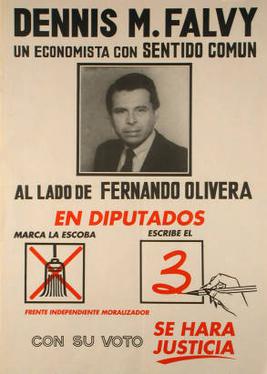
The Independent Moralizing Front was a Peruvian political party. At the legislative elections, 8 April 2001, the party won 11.0% of the popular vote and 11 out of 120 seats in the Congress of the Republic. Its presidential candidate at the elections of the same day, Luis Fernando Olivera Vega, won 9.9% of the vote. It was allied with former Peruvian president Alejandro Toledo's party, Peru Possible.

The Peru national basketball team is administrated by the Peru Basketball Federation (F.D.P.B.).
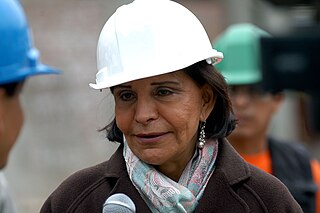
Mercedes Cabanillas Bustamante is a Peruvian educator and politician. A prominent member of the Peruvian Aprista Party, she served as Minister of Education in the first presidency of Alan García, making her the first woman to assume a cabinet position in the history of Peru. Most recently, she briefly served as Minister of Interior in Alan García's second presidency, a position subject to scrutiny as she was signaled as responsible of the repression of natives in the 2009 Amazon crisis, in Bagua, which forced her to resign, and effectively ended her political career.

Luis Alejandro Giampietri Rojas is a Peruvian politician belonging to the Peruvian Aprista Party and a retired admiral of the Peruvian Navy. Giampietri ran successfully as Alan García's first running mate in the 2006 general election, and was sworn in on 28 July 2006 and served until 28 July 2011. He was also elected as Congressman representing the Constitutional Province of Callao for the 2006-2011 term. He lost his seat in the 2011 elections when he ran for re-election under the Radical Change party, but he received a minority of votes and the Radical Change failed to pass the electoral threshold and subsequently lost its registration the following year. Before he served as Vice President and Congressman, Giampietri was a Lima City Councilman from 1999 to 2002, elected under the Fujimorist Vamos Vecino, close to-then President Alberto Fujimori.

Armando Villanueva del Campo was a Peruvian politician who was the leader of the Peruvian American Popular Revolutionary Alliance. Born in Lima, his parents were Pedro Villanueva Urquijo, a gynecologist in the city, and Carmen Rosa Portal del Campo. His only legitimate sibling was his older brother Ing. Pedro Villanueva del Campo Portal.
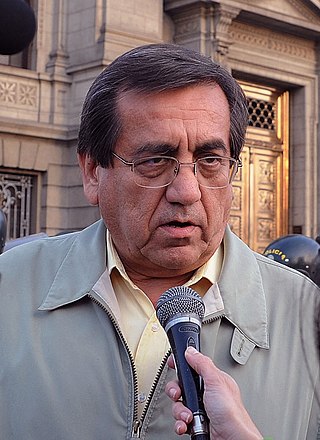
Jorge Alfonso Alejandro Del Castillo Gálvez is a Peruvian lawyer and politician. In his career, he has served in the now abolished Peruvian Chamber of Deputies between 1990 and 1992, in the unicameral Congress of the Republic for six non-consecutive terms, between 1995 and 2011 and again from 2016 to 2019, five of which are consecutive terms, and as Mayor of Lima and the District of Barranco during the 1980s.

Luis Alberto Félix Sánchez Sánchez was a Peruvian lawyer, jurist, philosopher, historian, writer and politician. A historic member of the Peruvian Aprista Party, he became a Senator and member of two Constitutional Assemblies, in which the second one (1978–1980), he occupied the Vice-Presidency of the Assembly and the Presidency of the Constitution Committee. During the Presidency of Alan García (1985–1990), he was his Second Vice President and was appointed for a short period as Prime Minister of Peru. In Congress he served as President of the Senate two occasions. He is the oldest Vice President of Peru, taking office at the age of 84 years, 289 days.
The National Prize for Arts and Sciences is awarded annually by the Government of Mexico in six categories. It is part of the Mexican Honours System and was established in 1945. The prize is a gold medal and 520,000 pesos.

Popular Force, known as Force 2011 until 2012, is a right-wing populist and Fujimorist political party in Peru. The party is led by Keiko Fujimori, former congresswoman and daughter of former President Alberto Fujimori. She ran unsuccessfully for the presidency in the 2011, 2016 and 2021 presidential elections, all losing by a narrow margin.
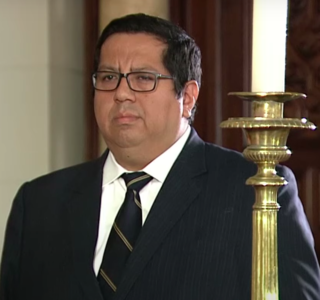
The Ministry of Economy and Finance of Peru is the government ministry responsible for the planning and execution of economic policies of the Peruvian Government with the goal of optimizing the economic and financial activities of the state, establish macroeconomic activity, and achieve the sustainable growth of the nation's economy. As of 11 December 2022, the minister of Economy and Finance is Alex Contreras.

General elections were held in Peru on 10 April 2011 to elect the President, the Vice Presidents, 130 members of Congress and five members of the Andean Parliament. As no presidential candidate received a majority in the first round, a second round was held on 5 June to determine the successor of outgoing president Alan García. Former army officer Ollanta Humala narrowly defeated Keiko Fujimori, daughter of imprisoned former President Alberto Fujimori. Humala was sworn in as the 94th President of Peru on 28 July.
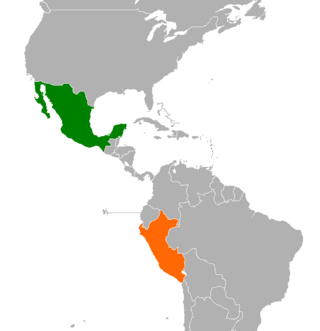
Mexican-Peruvian relations are the historical and current bilateral relationship between the United Mexican States and the Republic of Peru. Both nations are members of the Asia-Pacific Economic Cooperation, Community of Latin American and Caribbean States, Lima Group, Organization of Ibero-American States, Organization of American States, Pacific Alliance and the United Nations.
Events in the year 2019 in Peru.
![]() Media related to 1989 in Peru at Wikimedia Commons
Media related to 1989 in Peru at Wikimedia Commons